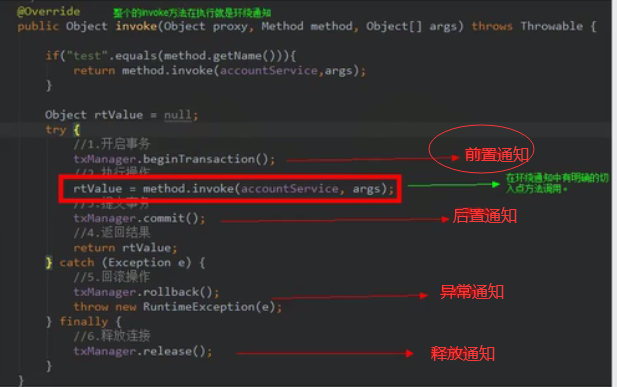动态代理
问题:为什么要用动态代理
因为要降低耦合成本,举个例子
你直接和工厂买东西,太麻烦,工厂也很麻烦
就出现了中间商,也就是代理
用到代码里就是,有重复的代码,他们大体相同。
比如结账,都是拿钱付账,A直接付帐,B拿着优惠卡再付帐。
付帐就成了公共代码,所以可以写个付钱代码,再用AOP面向切面的方法增强一下。真实举例:日志
我们先用一个别的,第三方类库提供的代理方法cglib。
核心是不修改源码的基础上对方法增强。
我们有两种:
1.只有厂家实现类的普通类使用cglib,要求普通类不能是final修饰的最终类
2.基于接口的,也就是有厂家接口和厂家实现类的,使用jdk
1.普通类
目的:有厂家,代理,拿货人,拿货人给了一万,代理拿到一万,给厂家八千
在创建一个代理。爆红是我没有导包

第三方的cglib库的使用方法:
1.使用新建提供的enhancer类的creat方法新建一个代理proxy对象cglibProducer,这个对象所获取的要是final类型
2.然后使用代理对象的invoke方法
final Producer producer = new Producer();
IProducer proxyProducer = (IProducer) Proxy.newProxyInstance(producer.getClass().getClassLoader(),
producer.getClass().getInterfaces(),
new InvocationHandler() {
/**
* 作用:执行被代理对象的任何接口方法都会经过该方法
* 方法参数的含义
* @param proxy 代理对象的引用
* @param method 当前执行的方法
* @param args 当前执行方法所需的参数
* @return 和被代理对象方法有相同的返回值
* @throws Throwable
*/
@Override
public Object invoke(Object proxy, Method method, Object[] args) throws Throwable {
//提供增强的代码
Object returnValue = null;
//1.获取方法执行的参数
Float money = (Float)args[0];
//2.判断当前方法是不是销售
if("saleProduct".equals(method.getName())) {//判断你要增强的方法名
returnValue = method.invoke(producer, money*0.8f);
}
return returnValue;
}
});
proxyProducer.saleProduct(10000f);
}
第二种,基于接口的动态代理
/**
* 执行北地阿里对象的任何方法都会经过该方法
* @param proxy
* @param method
* @param args
* 以上三个参数和基于接口的动态代理中invoke方法的参数是一样的
* @param methodProxy :当前执行方法的代理对象
* @return
* @throws Throwable
*/
final Producer producer = new Producer();
Producer cglibProducer = (Producer)Enhancer.create(producer.getClass(), new MethodInterceptor() //Enhancer直接用,导包里自带的 @Override public Object intercept(Object proxy, Method method, Object[] args, MethodProxy methodProxy) throws Throwable { //提供增强的代码,就是在这里重写的 Object returnValue = null; //1.获取方法执行的参数 Float money = (Float)args[0]; //2.判断当前方法是不是销售 if("saleProduct".equals(method.getName())) { returnValue = method.invoke(producer, money*0.8f); } return returnValue; } }); cglibProducer.saleProduct(12000f); }
补充:Service这个接口被增强了,有了两个实现类,所以我们在测试的时候,要使用@qualifier确定使用的是哪个测试类
AOP,aspect oriented programming,面向切面编程
两个术语
接入点:已经被拦截的方法,也就是你想增强的接口的所有方法。
切入点:对哪个方法进行拦截增强。
基于xml的面向切面编程配置
<?xml version="1.0" encoding="UTF-8"?> <beans xmlns="http://www.springframework.org/schema/beans" xmlns:xsi="http://www.w3.org/2001/XMLSchema-instance" xmlns:aop="http://www.springframework.org/schema/aop" xsi:schemaLocation="http://www.springframework.org/schema/beans http://www.springframework.org/schema/beans/spring-beans.xsd http://www.springframework.org/schema/aop http://www.springframework.org/schema/aop/spring-aop.xsd"> <!-- 配置srping的Ioc,把service对象配置进来--> <bean id="accountService" class="com.itheima.service.impl.AccountServiceImpl"></bean> <!--spring中基于XML的AOP配置步骤 1、把通知Bean也交给spring来管理 2、使用aop:config标签表明开始AOP的配置 3、使用aop:aspect标签表明配置切面 id属性:是给切面提供一个唯一标识 ref属性:是指定通知类bean的Id。 4、在aop:aspect标签的内部使用对应标签来配置通知的类型 我们现在示例是让printLog方法在切入点方法执行之前之前:所以是前置通知 aop:before:表示配置前置通知 method属性:用于指定Logger类中哪个方法是前置通知 pointcut属性:用于指定切入点表达式,该表达式的含义指的是对业务层中哪些方法增强 切入点表达式的写法: 关键字:execution(表达式) 表达式: 访问修饰符 返回值 包名.包名.包名...类名.方法名(参数列表) 标准的表达式写法: public void com.itheima.service.impl.AccountServiceImpl.saveAccount() 访问修饰符可以省略 void com.itheima.service.impl.AccountServiceImpl.saveAccount() 返回值可以使用通配符,表示任意返回值(比如这个接口有int,void两种不同的返回值,这样前面的void和int就可以省略成*) * com.itheima.service.impl.AccountServiceImpl.saveAccount() 包名可以使用通配符,表示任意包。但是有几级包,就需要写几个*. * *.*.*.*.AccountServiceImpl.saveAccount()) 包名可以使用..表示当前包及其子包 * *..AccountServiceImpl.saveAccount() 类名和方法名都可以使用*来实现通配 * *..*.*() 参数列表: 可以直接写数据类型: 基本类型直接写名称 int 引用类型写包名.类名的方式 java.lang.String 可以使用通配符表示任意类型,但是必须有参数 可以使用..表示有无参数均可,有参数可以是任意类型 全通配写法: * *..*.*(..) 实际开发中切入点表达式的通常写法: 切到业务层实现类下的所有方法 * com.itheima.service.impl.*.*(..) --> <!-- 配置Logger类 --> <bean id="logger" class="com.itheima.utils.Logger"></bean> <!--配置AOP--> <aop:config> <!--配置切面 --> <aop:aspect id="logAdvice" ref="logger"> <!-- 配置通知的类型,并且建立通知方法和切入点方法的关联--> <aop:before method="printLog" pointcut="execution(* com.itheima.service.impl.*.*(..))"></aop:before> </aop:aspect> </aop:config> </beans>
基于注解的AOP配置
<?xml version="1.0" encoding="UTF-8"?> <beans xmlns="http://www.springframework.org/schema/beans" xmlns:xsi="http://www.w3.org/2001/XMLSchema-instance" xmlns:aop="http://www.springframework.org/schema/aop" xmlns:context="http://www.springframewo
import org.aspectj.lang.ProceedingJoinPoint; import org.aspectj.lang.annotation.*; import org.springframework.stereotype.Component; /** * 用于记录日志的工具类,它里面提供了公共的代码 */ @Component("logger") @Aspect//表示当前类是一个切面类 public class Logger { @Pointcut("execution(* com.itheima.service.impl.*.*(..))")//表示切入哪里,就是增强那个接口或者实现类 private void pt1(){} /** * 前置通知 */ // @Before("pt1()") public void beforePrintLog(){ System.out.println("前置通知Logger类中的beforePrintLog方法开始记录日志了。。。"); } /** * 后置通知 */ // @AfterReturning("pt1()") public void afterReturningPrintLog(){ System.out.println("后置通知Logger类中的afterReturningPrintLog方法开始记录日志了。。。"); } /** * 异常通知 */ // @AfterThrowing("pt1()") public void afterThrowingPrintLog(){ System.out.println("异常通知Logger类中的afterThrowingPrintLog方法开始记录日志了。。。"); } /** * 最终通知 */ // @After("pt1()") public void afterPrintLog(){ System.out.println("最终通知Logger类中的afterPrintLog方法开始记录日志了。。。"); } /** * 环绕通知 * 问题: * 当我们配置了环绕通知之后,切入点方法没有执行,而通知方法执行了。 * 分析: * 通过对比动态代理中的环绕通知代码,发现动态代理的环绕通知有明确的切入点方法调用,而我们的代码中没有。 * 解决: * Spring框架为我们提供了一个接口:ProceedingJoinPoint。该接口有一个方法proceed(),此方法就相当于明确调用切入点方法。 * 该接口可以作为环绕通知的方法参数,在程序执行时,spring框架会为我们提供该接口的实现类供我们使用。 * * spring中的环绕通知: * 它是spring框架为我们提供的一种可以在代码中手动控制增强方法何时执行的方式。 */ @Around("pt1()")//环绕式 public Object aroundPringLog(ProceedingJoinPoint pjp){ Object rtValue = null; try{ Object[] args = pjp.getArgs();//得到方法执行所需的参数 System.out.println("Logger类中的aroundPringLog方法开始记录日志了。。。前置"); rtValue = pjp.proceed(args);//明确调用业务层方法(切入点方法) System.out.println("Logger类中的aroundPringLog方法开始记录日志了。。。后置"); return rtValue; }catch (Throwable t){ System.out.println("Logger类中的aroundPringLog方法开始记录日志了。。。异常"); throw new RuntimeException(t); }finally { System.out.println("Logger类中的aroundPringLog方法开始记录日志了。。。最终"); } } }
rk.org/schema/context" xsi:schemaLocation="http://www.springframework.org/schema/beans http://www.springframework.org/schema/beans/spring-beans.xsd http://www.springframework.org/schema/aop http://www.springframework.org/schema/aop/spring-aop.xsd http://www.springframework.org/schema/context http://www.springframework.org/schema/context/spring-context.xsd"> <!-- 配置spring创建容器时要扫描的包--> <context:component-scan base-package="com.itheima"></context:component-scan> <!-- 配置spring开启注解AOP的支持 --> <aop:aspectj-autoproxy></aop:aspectj-autoproxy> </beans>






